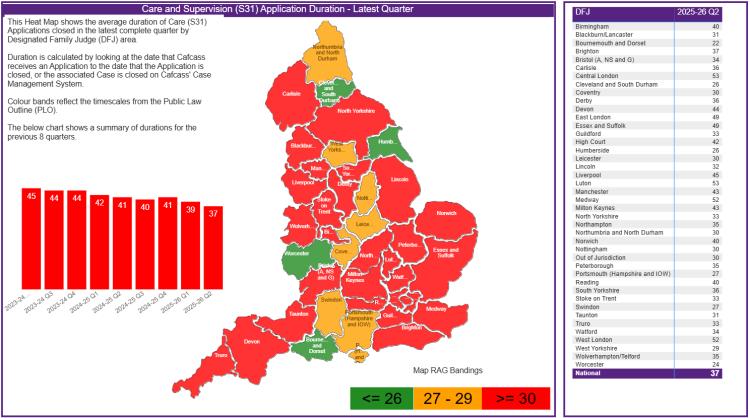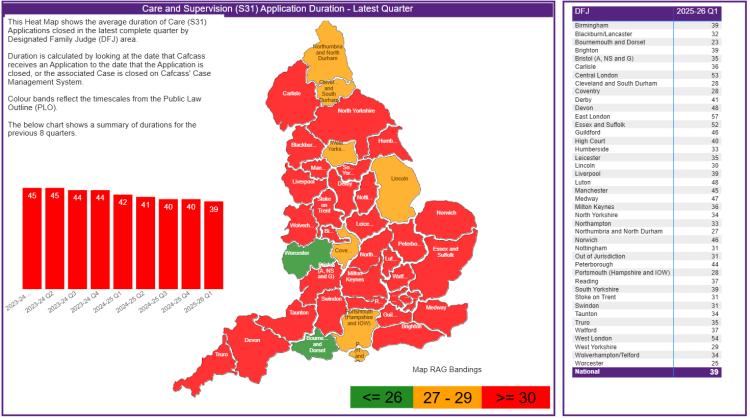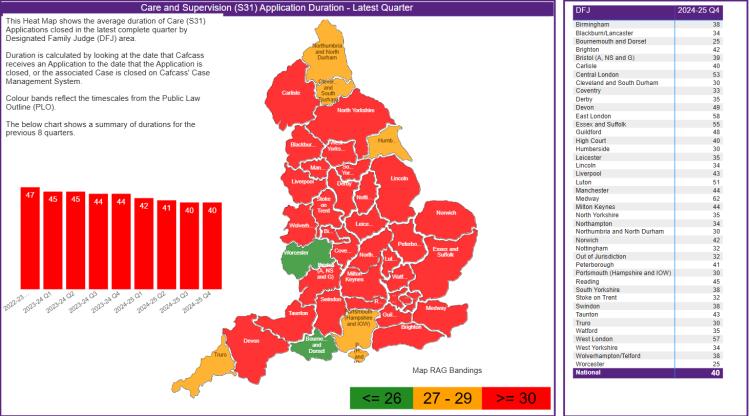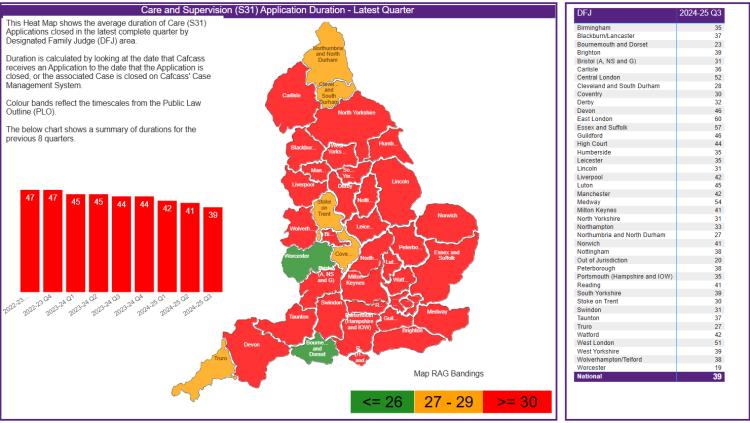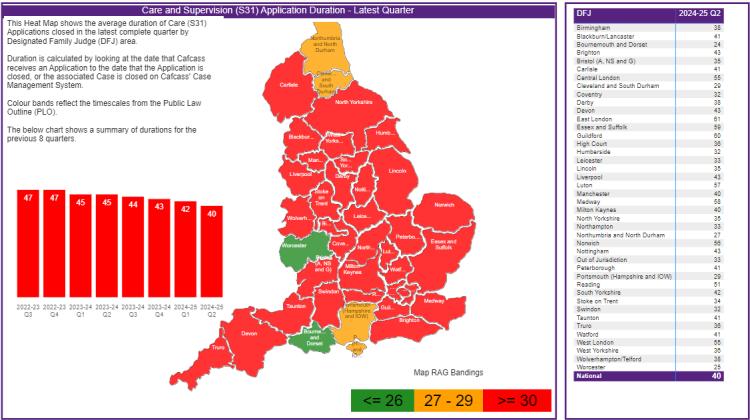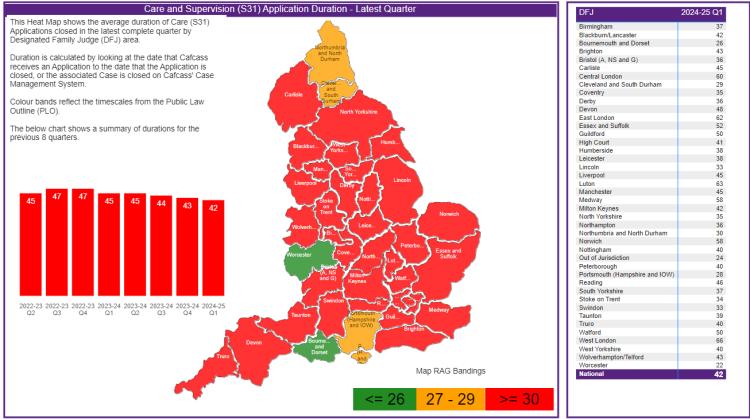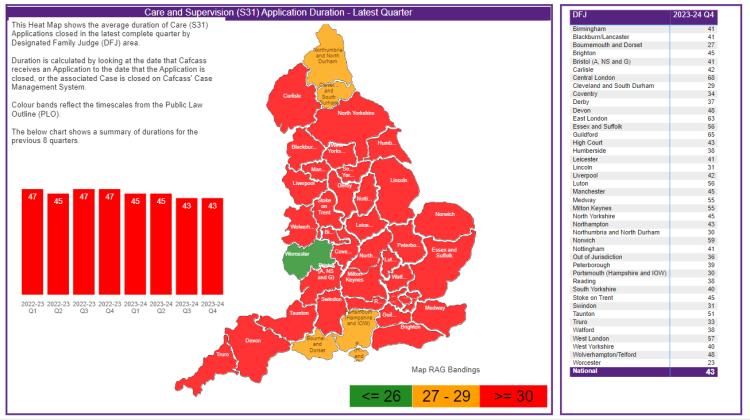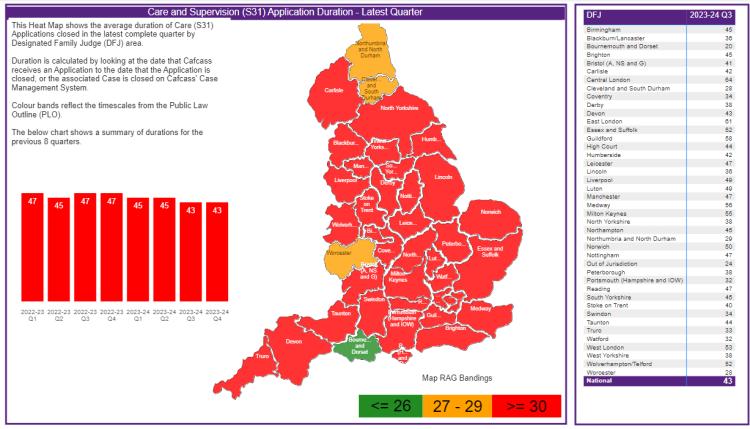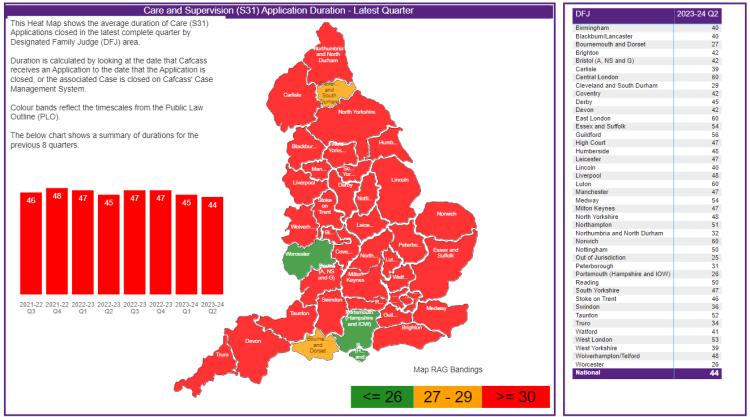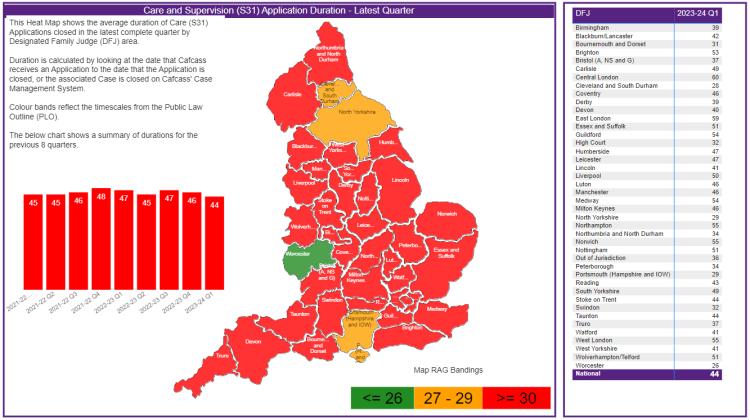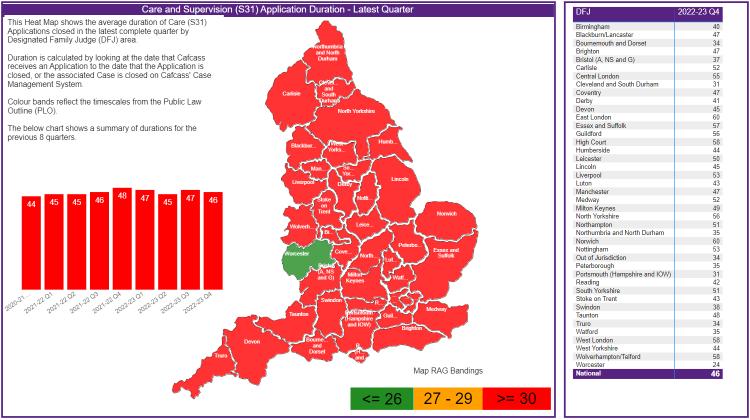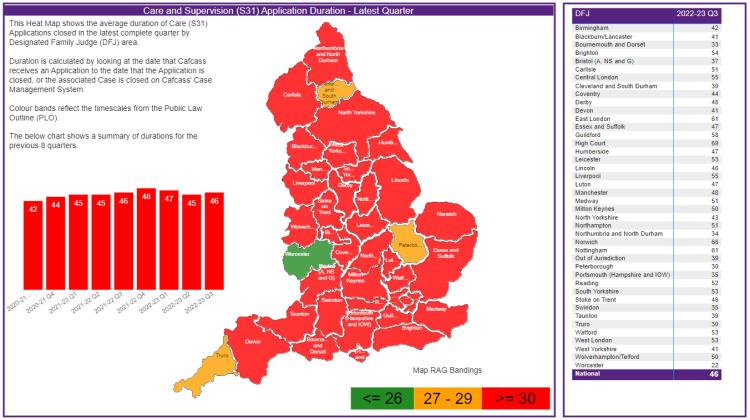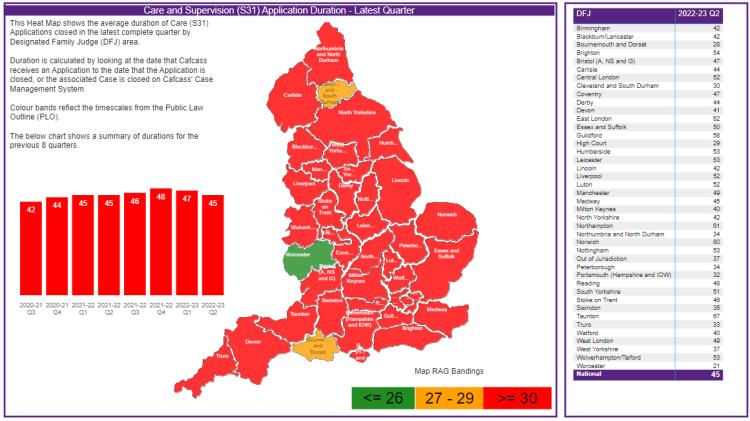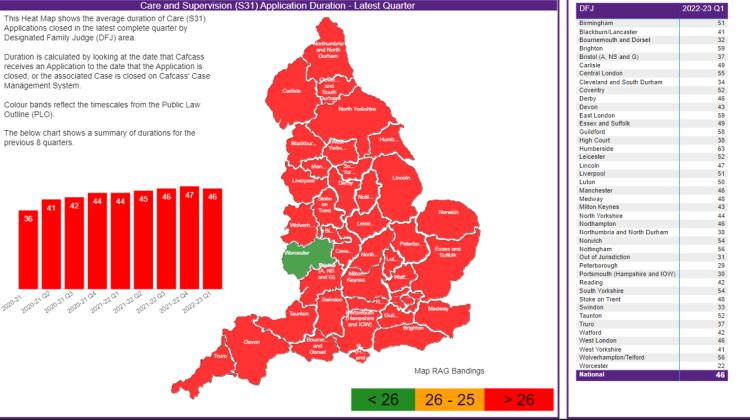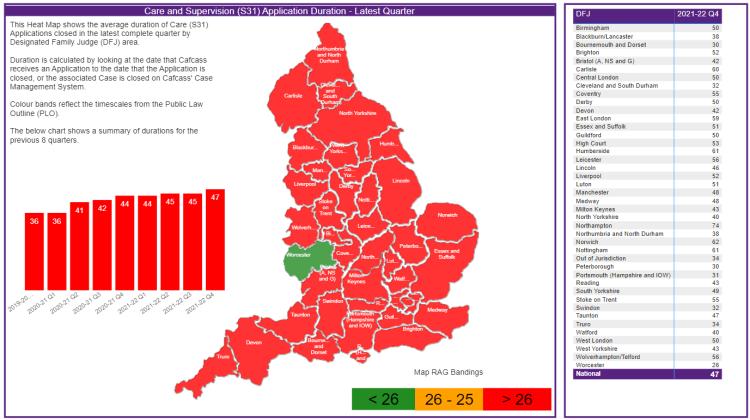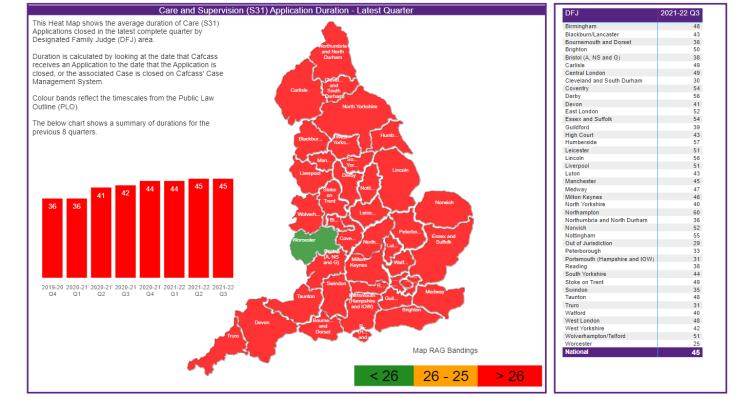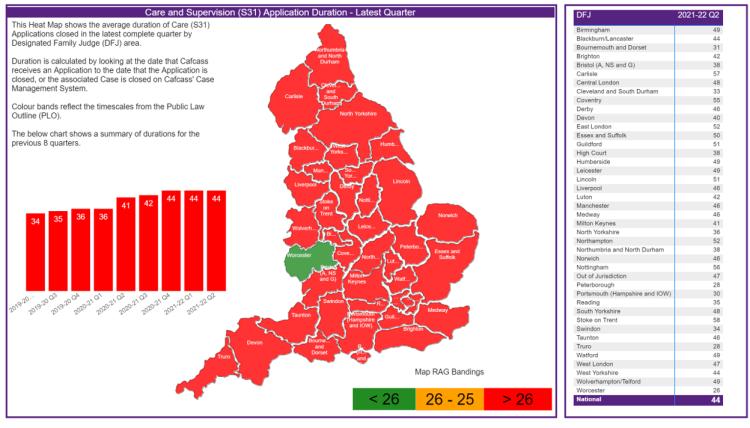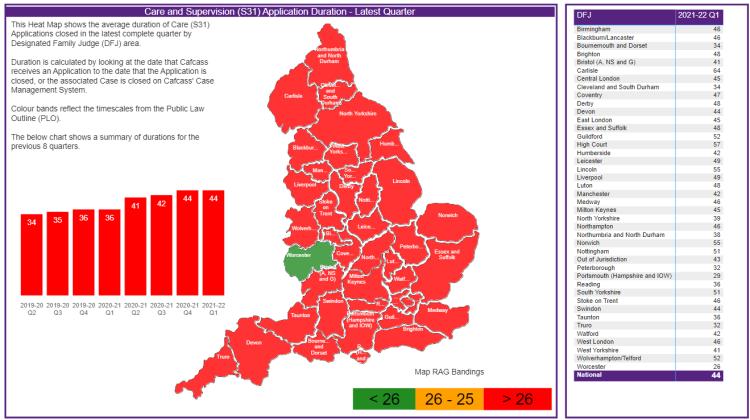Quarterly data
We collect data showing Public - Cafcass - LA Duration History.
Cafcass produces ‘heat maps’ showing how each Designated Family Judge (DFJ) area is performing in relation to the Public Law Outline target of 26 weeks.
Q2: 2025-26
The national average for care and supervision (s31) application duration is 37 calendar weeks.
Q1: 2025-26
The national average for care and supervision (s31) application duration is 39 calendar weeks.
Q4: 2024-25
The national average for care and supervision (s31) application duration is 40 calendar weeks.
Q3: 2024-25
The national average for care and supervision (s31) application duration is 39 calendar weeks.
Q2:2024-25
The national average for care and supervision (s31) application duration is 40 calendar weeks.
Q1: 2024-25
The national average for care and supervision (s31) application duration is 42 calendar weeks.
Q4: 2023-24
The national average for care and supervision (s31) application duration is 43 calendar weeks.
Q3: 2023-24
The national average for care and supervision (s31) application duration is 43 calendar weeks.
Q2: 2023-24
The national average for care and supervision (s31) application duration is 44 calendar weeks.
Please note the map data was ran on 26/01/24 and may differ from the data within the spreadsheets which ran on 26/11/23.
Q1: 2023-24
The national average for care and supervision (s31) application duration is 44 calendar weeks.
Q4: 2022-23
The national average for care and supervision (s31) application duration is 46 calendar weeks.
Q3: 2022-23
The national average for care and supervision (s31) application duration is 46 calendar weeks.
Q2: 2022-23
The national average for care and supervision (s31) application duration is 45 calendar weeks.
Q1: 2022-23
The national average for care and supervision (s31) application duration is 44 calendar weeks.
Q4: 2021-22
The national average for care and supervision (s31) application duration is 47 calendar weeks.
Q3: 2021-22
The national average for care and supervision (s31) application duration is 45 calendar weeks.
Q2: 2021-22
The national average for care and supervision (s31) application duration is 44 calendar weeks.
Q1: 2021-22
The national average for care and supervision (s31) application duration is 44 calendar weeks.
Please refer to the DFJ Duration Trend file for historical information – Public - DJF Care Application Duration History
Note: The duration is measured from when the application is issued to when the application completes. Applications may be in relation to one child only or many children. All average durations are presented to the nearest whole week and calculated from the total number of calendar days it takes to complete. See below for more details on how the calculations are made.
Cafcass Section 31 Application Durations
The purpose of this document is to explain why courts and local authorities may produce Section 31 application duration figures that differ to Cafcass. It is not expected that the durations reported by different organisations will match exactly, but they should be within a reasonable distance of each other.
- Each Section 31 care application and Section 31 supervision application that concludes in the time period being reported has a duration (not each child or each case).
- There may be multiple applications on a case and all concluded Section 31 applications are used in the average duration calculation according to the quarter they concluded in. Consolidated applications (new applications made during proceedings) will be entered into the existing case and will have their own duration, as above.
- The LA is picked up from the application information entered in ChildFirst; therefore, proceedings that are transferred to another LA will still be counted as the LA that submitted them. When reporting by the LA field, the applications selected are based solely on the LA field, regardless of the DFJ.
- The court and the associated DFJ are picked up from the last entered hearing on the case. When reporting by these fields, the applications selected are based solely on these fields, regardless of the LA. If the case has no hearings, the Court and DFJ will be picked up from the application.
- The duration is calculated from application issue to application completed date. Where an application completed date is not available, the calculation will look at the case closure date. In ChildFirst, the completed date was set by entering the final legal output against the relevant hearing at which it was made. In ChildFirst, the completion date is entered independently of hearings or legal outputs.
- The calculation is made by counting the calendar days between these two dates and dividing by 7 (the number of working days in the week).
- Data is reported a month and a half behind the quarter, concluding to allow system updates and to minimise changes in average durations when data is updated.
- No restrictions are made on when the application was applied for, i.e. durations will cover pre- and post-revised PLO cases if they have closed in the quarters being reported on.
- Heat map data is provided for the last two quarters. To review previous quarters durations, the excel table of durations should be viewed, which is accessible on the Cafcass website.
- MOJ/ HMCTS use child-based duration data to allow for different outcomes for different children at different times.
- LAs often report based on families. Where applications are consolidated, the duration for all children is then reported together.
- Possible differences in duration calculations, e.g. working days.
- Naturally, there is the possibility of human error in entering information into any of the databases used to monitor these durations.
If you have a query based on the duration Cafcass is reporting that you do not think is accounted for by one of the above differences, please first check your figures for accuracy and then ask that Cafcass do the same. If this does not resolve differences when the next quarter’s information is released, please request a more detailed look at both data sets being compared.
